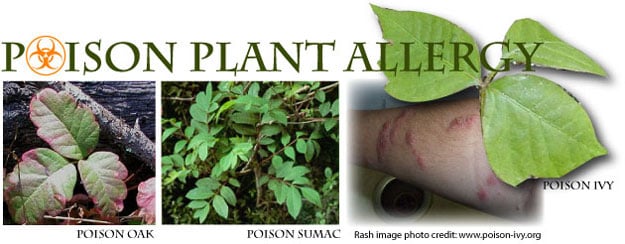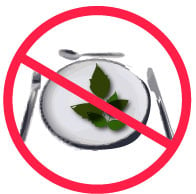Toxicodendron Dermatitis: Poison Plant Allergy

Urushiol (pronounced “ooh-roosh-ee-all”) is one bad allergen. While approximately 10% of Americans are sensitive to dust mite allergen, a whopping90% of Americans are sensitive to urushiol.
Urushiol is the yellow oil found in plants of the Family Anacardiaceae, especially those of the Genus Toxicodendron, including poison ivy, poison oak, andpoison sumac. It’s also found in the resin of the Japanese lacquer tree, and its name comes from the Japanese word for the lacquer: urushi.
As early as 7,000 BC, Japanese people used urushiol to make hard, lacquer finishes, but they had to be careful to avoid touching the fresh urushiol, or else they would experience an allergic skin rash known as toxicodendron dermatitis, or urushiol-induced contact dermatitis.
The rash normally appears 24 hours after contact and clears up within two weeks. Symptoms include itching, blistering, oozing, inflammation, and sometimes a burning sensation. The American Academy of Dermatology estimates that about 50 million Americans suffer from toxicodendron dermatitis each year.
Leaves of Three, Let It Be
 Poison oak (which is not really oak) grows in the western and southern United States, while poison ivy (which is not really ivy) grows widely in the eastern U.S.
Poison oak (which is not really oak) grows in the western and southern United States, while poison ivy (which is not really ivy) grows widely in the eastern U.S.
Poison sumac is not nearly as common – it grows well only in extremely wet soil (like in swamps and peat bogs) in the eastern U.S. and Canada – but it is possibly the most toxic plant in the U.S. The dermatitis caused by poison sumac is typically much worse than that caused by poison ivy or poison oak.
“Leaves of three, let it be” is an old saying to help people remember which plants they should avoid; however, this advice is not completely true. While poison oak and poison ivy usually have three leaflets, some plants may have five or seven leaflets. Poison sumac, which grows in the form of a small tree or shrub, has seven to thirteen leaflets.
Urushiol may be transferred to the skin from clothing or tools, so it’s important to wash clothing and other materials with soap and water after exposure to poisonous plants.
You should also avoid burning toxicodendron plants. Inhaling the smoke of the burning plants can cause diarrhea and other internal problems. Eating a toxicodendron plant is another bad idea that could result in a serious – even fatal – reaction.
Toxicodendron Dermatitis Treatment
If you are exposed to a toxicodendron plant, you should wash the exposed area(s) as soon as possible with soap and water. Wash thoroughly, but do not use hot water and do not scrub too hard.
Within 15 minutes after exposure, you can remove most urushiol with soap and water, but after that, the urushiol is chemically bonded to the skin. Urushiol binds to the living layer of dermal skin (below the outer layer of dead epidermis) and changes the configuration of the living cells. This change in configuration illicits an immune response because the immune system no longer recognizes those cells as “self.”
Some pharmaceutical products, like Tecnu and Zanfel, have the ability physically remove the bonded urushiol. Ask your pharmacist for more information about these products.
Standard treatments for pain relief and itch reduction include cold compresses, calamine lotion, antihistamines, and hydrocortisone.
Discredited Myths about Poison Plant Allergy
 |
Few conditions have produced as many old wives tales as the poison plant allergies.
|
- You are not immune to poison plant allergy after the first exposure. In fact, since this is an allergic reaction instigated by antibodies, many people become more sensitive to urushiol with subsequent exposures.
- Dead plants are not safe. Urushiol remains active for up to five years.
- Ice, water, and lotions do not help cure the rash; they only soothe the itch.
- You do not become immune to poison plants by eating them; this is a dangerous old wives tale.
- Urinating on the rash does not help. Please do not try this at home, or anywhere else for that matter.
And remember, even if you’re one of those lucky individuals who appears to be immune to poison plant allergies, an allergy can develop at any point in your life, and the more you’re exposed to an allergen, the more likely you are to develop an allergy.
For more information about the development of allergies, see How to Decrease Your Total Allergen Load.
